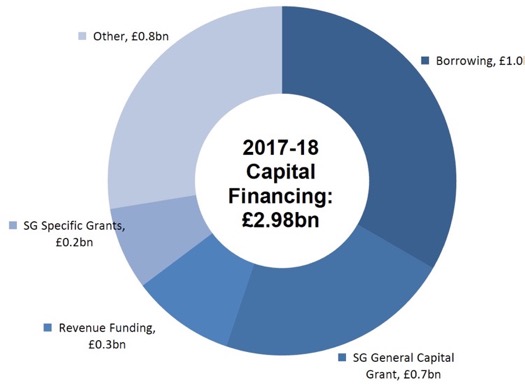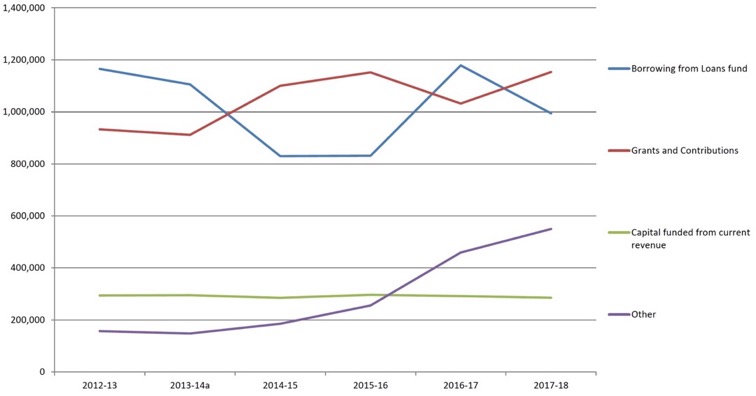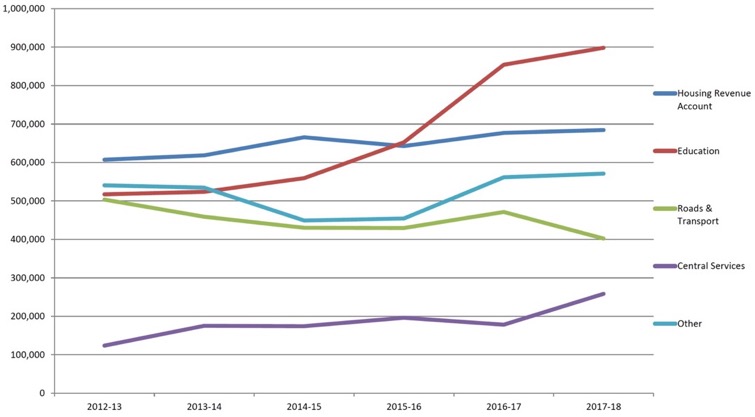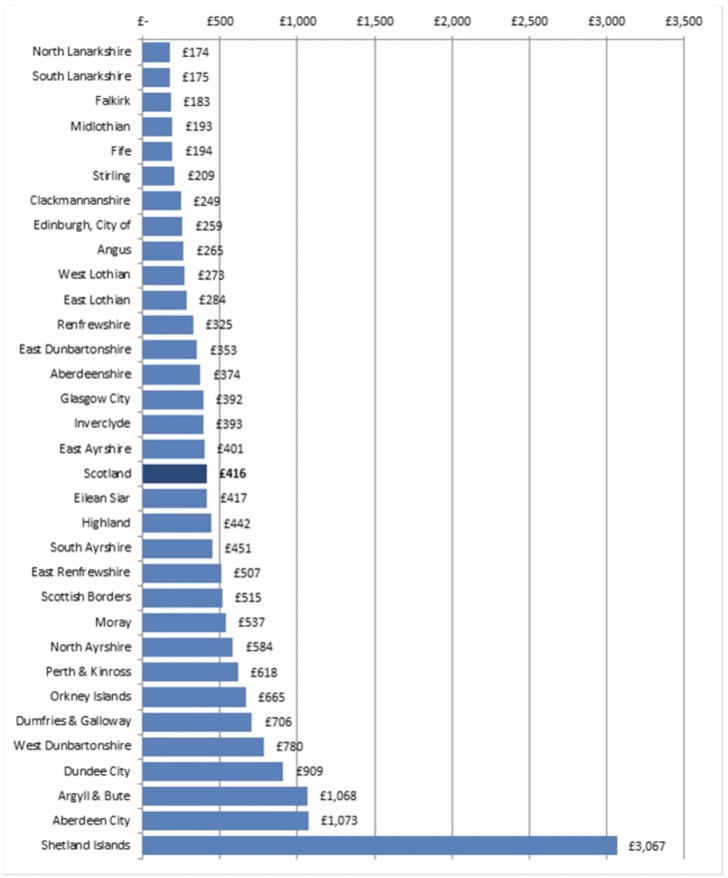Scottish local government financial statistics 2017-2018
Annual publication providing a comprehensive overview of financial activity of Scottish local authorities based on authorities audited accounts.
This document is part of a collection
2. Capital Expenditure and Financing
Spend which creates an asset that the authority will use over several years, such as building schools or buying vehicles, is known as Capital Expenditure.
Whilst a local authority cannot borrow to finance day-to-day expenditure, capital expenditure may be funded from borrowing. The costs of repaying the debt, including the interest costs, are met from the revenue account.

- Total Capital Expenditure: £2.98 billion - an increase of 0.7% on 2016-17;
- Education has the largest share (30%) of capital expenditure with £0.90bn - an increase of 5% on 2016-17;
- The Housing Revenue Account (HRA) is the second largest service area with 23% (£0.68bn) of capital expenditure – an increase of 1% from 2016-17;
- 76% of capital expenditure is on constructing or enhancing buildings;
- 33% (£0.99bn) of expenditure is financed through borrowing.
2.1 Total Capital Expenditure and Financing
Capital expenditure by local authorities is mainly for purchasing, constructing or enhancing physical assets, such as buildings (e.g. care homes or schools), land (e.g. playing fields), infrastructure (e.g. roads and flood defences), and vehicles, plant and machinery. Generally, capital expenditure is expenditure that creates an asset, extends the life of an asset or increases the value of an asset. Capital expenditure also includes expenditure that legislation permits local authorities to treat as capital expenditure and meet from capital resources, such as capital grants to third parties, where the asset it creates or improves is not owned by the local authority.
Capital expenditure is financed by one or more of the following:
- Capital grants and contributions;
- Borrowing or Credit Arrangements;
- Contributions from capital or revenue reserve funds;
- Capital receipts from asset sales.
Unlike revenue expenditure, local authorities can borrow to fund capital expenditure. The Local Government (Scotland) Act 1973, provides councils with a general power to borrow. Other local authorities’ powers are set out in legislation specific to that authority. The Local Authority (Capital Finance and Accounting) (Scotland) Regulations 2016 sets out the purposes for which a local authority may borrow. The Local Government in Scotland Act 2003 places a local authority under a statutory duty to set their own maximum capital expenditure limits. These limits must be set with regard to the Chartered Institute of Public Finance & Accountancy ( CIPFA ) Prudential Code, which requires that capital expenditure plans by local authorities must be affordable, prudent and sustainable. Detailed breakdowns of Capital Expenditure can be found in Annexes G and H.
In 2017-18 total gross capital expenditure was £2.81 billion. In addition to this, local authorities funded £0.18 billion of revenue expenditure from capital resources. This was mostly funding third party capital projects. The total expenditure funded from capital resources was £2.98 billion in 2017-18, with £0.68 billion in the housing revenue account and £2.30 billion in the General Fund.
Table 2.1 – Total Capital Expenditure and Financing, 2017-18
£thousands
| General Fund Services |
Housing Revenue Account |
Total |
|
|---|---|---|---|
| Acquisition of land, leases, existing buildings or works |
320,578 |
42,042 |
362,620 |
| New construction, conversions & enhancement to existing buildings |
1,619,051 |
634,799 |
2,253,850 |
| Vehicles, machinery & equipment |
179,008 |
5,655 |
184,663 |
| Intangible assets |
4,674 |
0 |
4,674 |
| Total Gross Capital Expenditure |
2,123,311 |
682,496 |
2,805,807 |
| Revenue Expenditure funded from Capital Resources |
175,006 |
1,856 |
176,862 |
| Total Expenditure to be met from Capital Resources |
2,298,317 |
684,352 |
2,982,669 |
| Scottish Government General Capital Grant |
651,836 |
0 |
651,836 |
| Scottish Government Specific Capital Grants |
159,281 |
69,202 |
228,483 |
| Grants from Scottish Government Agencies and NDPBs |
74,520 |
11,785 |
86,305 |
| Other Grants and Contributions |
151,531 |
35,028 |
186,559 |
| Borrowing from Loans Fund |
739,527 |
254,849 |
994,376 |
| Capital receipts used from asset sales/disposals |
49,625 |
72,342 |
121,967 |
| Capital Reserves (Capital Fund) |
31,342 |
0 |
31,342 |
| Capital funded from revenue reserves |
44,439 |
241,146 |
285,585 |
| Assets acquired under credit arrangements (e.g. finance leases, PPP /PFI) |
396,216 |
0 |
396,216 |
| Total Financing |
2,298,317 |
684,352 |
2,982,669 |
Source: Capital Returns (CRFinal)
The majority (76%) of capital expenditure went on new construction, conversions and enhancements to existing buildings.
Local authorities received a total of £1.15 billion (39% of total financing) in grants and contributions to fund capital expenditure (£1.04 billion in the General Fund and £0.12 billion for the HRA ). The most significant source of financing was borrowing (advances from the Loans Fund). This funded £0.99 billion (33% of total financing, £0.74 billion in the General Fund and £0.25 billion in the HRA ) of capital expenditure, a decrease of 16% on 2016-17.
Table 2.2 – Total Capital Expenditure and Financing, 2012-13 to 2017-18
£thousands
| 2013-14 |
2014-15 |
2015-16 |
2016-17 |
2017-18 |
|
|---|---|---|---|---|---|
| Acquisition of land, leases, existing buildings or works |
90,335 |
63,604 |
58,200 |
233,340 |
362,620 |
| New construction, conversions & enhancement to existing buildings |
1,967,310 |
1,948,992 |
2,096,542 |
2,357,953 |
2,253,850 |
| Vehicles, machinery & equipment |
189,509 |
174,443 |
182,501 |
193,195 |
184,663 |
| Intangible assets |
13,119 |
14,061 |
6,155 |
9,798 |
4,674 |
| Total Gross Capital Expenditure |
2,260,273 |
2,201,100 |
2,343,398 |
2,794,286 |
2,805,807 |
| Revenue Expenditure funded from Capital Resources |
199,728 |
199,002 |
191,818 |
167,605 |
176,862 |
| Total Expenditure to be met from Capital Resources |
2,460,001 |
2,400,102 |
2,535,216 |
2,961,891 |
2,982,669 |
| 0 |
|||||
| Scottish Government General Capital Grant |
438,163 |
680,491 |
694,346 |
504,464 |
651,836 |
| Scottish Government Specific Capital Grants |
180,549 |
203,444 |
201,914 |
224,925 |
228,483 |
| Grants from Scottish Government Agencies and NDPBs |
150,761 |
108,610 |
112,017 |
117,836 |
86,305 |
| Other Grants and Contributions |
142,077 |
107,731 |
143,418 |
184,761 |
186,559 |
| Borrowing from Loans fund |
1,105,526 |
829,701 |
831,327 |
1,178,810 |
994,376 |
| Capital receipts used from asset sales/disposals |
92,167 |
107,919 |
173,392 |
187,159 |
121,967 |
| Capital Fund applied |
24,798 |
34,595 |
60,374 |
65,282 |
31,342 |
| Capital funded from current revenue |
295,335 |
284,911 |
296,702 |
291,636 |
285,585 |
| Assets acquired under credit arrangements (e.g. finance leases, PPP /PFI) |
30,625 |
42,701 |
21,726 |
207,018 |
396,216 |
| Total Financing |
2,460,001 |
2,400,102 |
2,535,216 |
2,961,891 |
2,982,669 |
Source: Capital Returns (CRFinal)
Between 2016-17 and 2017-18, total capital expenditure to be met from capital resources increased by 0.7% (£0.02 billion). The amount of capital expenditure that is financed by grants from the Scottish Government, including Scottish Government Agencies and Non-Departmental Public Bodies increased by 12% (£0.12 bn) between 2016-17 and 2017-18.
The amount of capital expenditure financed through Borrowing from the Loans Fund has decreased by 16% between 2016-17 and 2017-18.
Over the spending review period, the grant allocations for individual years were adjusted as follows: -£120m in 2012-13, -£100m in 2013-14 and +£120m in 2014-15 with the remaining £94.2m allocated in 2015-16. Although the sum to be added back was originally £100 million this was reduced proportionately to £94.2 million following the transfer of the police and fire functions to the Scottish Government.
The profile of the capital grant allocations largely explain the decrease in grant funding and corresponding increase in borrowing, shown in Chart 2.1 below. The 2017-18 grant level is now closer to the level of capital grant that we would expect had the capital grant not been re-profiled.
Chart 2.1 – Capital Expenditure Financing
£thousands

a. Following the Police and Fire Reform (Scotland) Act 2012 figures for 2013-14 onwards may not be comparable with previous years. See Background to Local Government section for details.
Source: Capital Returns (CRFinal)
In 2017-18, Education capital expenditure increased by 5% to £898 million, which represents 30% of total capital expenditure. The HRA is the service with the second highest expenditure at £684 million, an increase of 1% on 2016-17 and representing 23% of total capital expenditure.
Table 2.3 – Capital Expenditure by Service, 2013-14 to 2017-18
£thousands
| 2013-14 |
2014-15 |
2015-16 |
2016-17 |
2017-18 |
|
|---|---|---|---|---|---|
| Education |
523,776 |
559,309 |
652,552 |
854,325 |
898,147 |
| Cultural & Related Services |
148,933 |
121,778 |
160,315 |
219,850 |
168,605 |
| Social Work |
80,849 |
73,690 |
62,553 |
64,701 |
42,555 |
| Roads & Transport |
458,876 |
430,265 |
429,569 |
471,361 |
402,035 |
| Environmental Services |
188,525 |
138,267 |
128,063 |
129,604 |
100,435 |
| Planning & Development Services |
94,415 |
66,488 |
90,416 |
200,832 |
258,444 |
| Central Services |
175,153 |
174,094 |
195,922 |
178,082 |
258,494 |
| Non-HRA Housing |
156,699 |
165,543 |
166,452 |
162,689 |
152,734 |
| Trading Services |
14,059 |
5,171 |
6,720 |
3,643 |
16,868 |
| Total General Fund Capital Expenditure |
1,841,285 |
1,734,605 |
1,892,562 |
2,285,087 |
2,298,317 |
| Housing Revenue Account |
618,716 |
665,497 |
642,654 |
676,804 |
684,352 |
| Total Capital Expenditure |
2,460,001 |
2,400,102 |
2,535,216 |
2,961,891 |
2,982,669 |
Source: Capital Returns (CRFinal)
Chart 2.2 – Capital Expenditure by Service, 2012-13 to 2017-18
£thousands

Source: Capital Returns (CRFinal)
In any given year capital expenditure per head varies substantially between local authority areas. This will in part reflect the different priorities of local authorities however it also reflects differences in the timing of capital projects. Expenditure on capital projects can be highly variable as some projects can be high-value and infrequent, and expenditure per head in local authority areas will move (possibly substantially) from year to year as projects begin or wind down.
Chart 2.3 – General Fund Capital Expenditure per Head by Council, 2017-18

Source: Capital Returns (CRFinal) & National Records of Scotland Mid-Year Population Estimates
2.2 Capital Financing
Capital Grants
Capital grants are grants provided to local authorities to fund capital investment. The Scottish Government provides two types of grant funding to local authorities – a General Capital Grant and a number of specific or ring-fenced grants. Scottish Government Agencies, such as Transport Scotland, and Non-Departmental Bodies such as sportscotland may also award grants for projects. Other grants and contributions include grants from other local authorities, European Structural Funds, contributions from private developers or persons, and the use of council tax discounts from second homes or long term empty properties. Chart 2.1 (above) provides a time series of grant income from 2012-13 to 2017-18.
Capital Receipts
‘Capital receipts’ is the term used to recognise income from the sale or disposal of a fixed asset, such as land or council housing. Under statute, capital receipts may only be used to fund capital expenditure or for the repayment of debt.
Table 2.4 details capital receipts categorised by service from 2013-14 to 2017-18. In order to reflect the corporate nature of assets and to promote good asset management practices local authorities commonly move assets to "Central Services" (which includes "Other Services" categorisation in this table) when they become identified as surplus for disposal. This can be seen from the table where in recent years for General Fund services, the greatest value of capital receipts has generally been reported against "Central Services". A detailed breakdown of Capital Receipts by Service for 2017-18 can be found in Annex J.
Total Capital Receipts raised decreased by 34%, from £208 million in 2016-17 to £137m in 2017-18. The Housing (Scotland) Act 2014 repeals the Right-to-Buy provisions, and this came into force from the 1 st August 2016. This will affect the value of Housing Revenue Account capital receipts, which decreased by 48% in 2017-18 on the previous year due to a the decline in Right to Buy applications. Culture & Related Services capital receipts fell by 90% in 2017-18, however the 2016-17 figure was unusually high due to a number of one-off high-value receipts.
Table 2.4 – Capital Receipts Raised by Service, 2013-14 to 2017-18
£thousands
| 2013-14 |
2014-15 |
2015-16 |
2016-17 |
2017-18 |
|
|---|---|---|---|---|---|
| Education |
13,798 |
15,498 |
16,324 |
12,572 |
11,879 |
| Culture & Related Services |
3,574 |
1,526 |
2,696 |
13,464 |
1,409 |
| Social Work |
2,632 |
5,574 |
1,306 |
4,311 |
2,823 |
| Roads & Transport |
1,742 |
21,398 |
2,086 |
2,968 |
3,903 |
| Environmental Services |
1,378 |
1,538 |
1,669 |
1,744 |
10,485 |
| Planning & Development Services |
58,276 |
22,163 |
117,742 |
12,989 |
11,639 |
| Central Services |
28,128 |
25,930 |
18,781 |
21,128 |
22,110 |
| Non-HRA Housing |
198 |
666 |
138 |
59 |
687 |
| Trading Services |
6 |
8 |
7,552 |
10 |
188 |
| Total GF Capital Receipts |
109,732 |
94,302 |
168,294 |
69,245 |
65,123 |
| Housing Revenue Account |
53,529 |
70,594 |
81,385 |
138,414 |
71,828 |
| Total Capital Receipts |
163,261 |
164,896 |
249,679 |
207,659 |
136,951 |
Source: Capital Returns (CRFinal)
Capital receipts can be used to finance capital expenditure and repay debt (principal but not interest). These receipts are generated through the sale or disposal of assets, such as a council house or other local authority land/building. Authorities can hold Capital Receipts for future use. As such, capital receipts received and capital receipts used are not necessarily equal.
Table 2.5 – Capital receipts summary, 2017-18
£thousands
| General Fund |
Housing Revenue Account |
Total |
|
|---|---|---|---|
| Capital receipts brought forward at 1 April 2017 |
82,908 |
9,782 |
92,690 |
| Capital receipts from the sale/ disposal of fixed assets |
65,123 |
71,828 |
136,951 |
| Total Capital Receipts Available for Use |
148,031 |
81,610 |
229,641 |
| Capital receipts used from asset sales/disposals |
49,625 |
72,342 |
121,967 |
| Capital receipts used to repay debt |
1,600 |
2,160 |
3,760 |
| Capital receipts transferred to the equal pay or severance statutory adjustment account |
2,110 |
0 |
2,110 |
| Capital receipts transferred to Capital Fund |
(10) |
0 |
(10) |
| Capital Receipts Held 31 March 2018 |
94,706 |
7,108 |
101,814 |
Source: Capital Returns (CRFinal)
Table 2.5 shows that authorities had a total of £230 million of capital receipts available for use during 2017-18, of which £93 million was the balance brought forward at 1st April 2017 and £137 million were raised during the year from the sale/disposal of fixed assets.
The main use of capital receipts in 2017-18 was to finance capital expenditure (£122 million), with a further £4 million used to repay debt. Around £2 million was used to pay for equal pay or severance costs. This resulted in a Capital receipts balance of £102 million at the 31st March 2018.
2.3 Borrowing and Credit Arrangements
Local authorities may borrow for the purposes of:
- Acquiring land;
- Construction of buildings;
- Undertaking permanent work or provision of plant and machinery;
- Lending to relevant authorities or Community Councils;
- Any other purpose for which the authority is authorised under any enactment to borrow.
Local authorities are required by legislation to maintain a Loans Fund. All money borrowed by local authorities must be paid into this Loans Fund, which then makes advances to service accounts to fund capital expenditure. The Scottish Government monitors the value of debt recorded in the Loans Fund (rather than the level of external debt) because it is this amount of debt that is charged to services over a period of time. The value of external debt is monitored as part of the prudential indicators of the local authority. See section 3.4 for more details.
The total amount of Loans Fund borrowing in 2017-18 was £0.99 billion. This is a decrease of 16% on 2016-17 and an decrease of 10% on 2013-14. When interpreting the pattern of borrowing over the period from 2013-14 to 2017-18, the re-profiling of the capital grant allocations over the spending review period should be kept in mind (-£120m in 2012-13, -£100m in 2013-14, +£120m in 2014-15 and +£94.2m allocated in 2015-16, with the remaining £5.8m allocated to Police and Fire). Of the total Loans Fund borrowing, £739 million (down 23%) was in the General Fund and £254 million (up 13%) was in the HRA.
Table 2.6 – Loans Fund Borrowing to Finance Capital Expenditure – 2013-14 to 2017-18
£thousands
| 2013-14 |
2014-15 |
2015-16 |
2016-17 |
2017-18 |
|
|---|---|---|---|---|---|
| General Fund |
788,568 |
518,296 |
558,669 |
954,113 |
739,018 |
| Advances for Capital Expenditure |
751,634 |
489,774 |
536,044 |
941,400 |
728,269 |
| Advances for Consented Borrowing |
36,934 |
28,522 |
22,625 |
12,713 |
10,749 |
| Housing Revenue Account |
316,958 |
311,404 |
272,658 |
224,697 |
254,849 |
| Advances for Capital Expenditure |
316,815 |
311,404 |
272,658 |
224,697 |
254,849 |
| Advances for Consented Borrowing |
143 |
0 |
0 |
0 |
0 |
| Total Loans Fund Borrowing |
1,105,526 |
829,701 |
831,327 |
1,178,810 |
993,867 |
| Credit Arrangements |
30,625 |
42,701 |
21,726 |
207,018 |
396,216 |
| Total Borrowing and Credit Arrangements |
1,136,151 |
872,402 |
853,053 |
1,385,828 |
1,390,083 |
Source: Capital Returns (CRFinal)
The costs of servicing debt is mostly met from taxation and non-specific grant income, while the costs of servicing Housing Revenue Account (HRA) debt are met principally through income from rents. The costs of servicing debt are detailed in Table 1.1 which shows interest payable and the cost of repayments (Statutory Repayment of Debt).
There is a problem
Thanks for your feedback